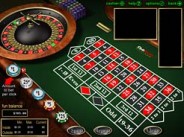Which Numbers Should You Bet on in Roulette?
 Basil Nestor is the author of the new Playboy Complete Guide to Casino Gambling. This wonderful book teaches players how to avoid sucker bets and win more when playing gambling games. He is also the author of The Smarter Bet Guide series for video poker, slots, craps, and many other books about gambling. Basil's website is www.smarterbet.com on a roulette wheel are arranged in a system that is designed specifically for maximum variability. Red and black alternate; pairs of odd and even alternate; pairs of high and low alternate. Every odd number has its even successor directly across the wheel.
Basil Nestor is the author of the new Playboy Complete Guide to Casino Gambling. This wonderful book teaches players how to avoid sucker bets and win more when playing gambling games. He is also the author of The Smarter Bet Guide series for video poker, slots, craps, and many other books about gambling. Basil's website is www.smarterbet.com on a roulette wheel are arranged in a system that is designed specifically for maximum variability. Red and black alternate; pairs of odd and even alternate; pairs of high and low alternate. Every odd number has its even successor directly across the wheel. European single-zero wheels also use a standardized system, but the order of the numbers is different.
The roulette table is as ingenious as the wheel. Numbers are arranged sequentially, but the patterns of red, black, high, low, odd, and even, create betting options that correspond to the wheel's layout and ensure that no bet has an advantage over any other bet. The table can accommodate dozens of unique wagers; all of them have various probabilities of success, and yet all of them (with one exception) have an exactly identical house edge.
It's truly a mathematic marvel, relentlessly systematic yet utterly unpredictable. Here are the numbers in sequential order as they appear on an American double-zero wheel:

Zero is between 2 and 28. Double zero is between 1 and 27.
All roulette bets on an American wheel have a house edge (advantage for the casino) of 5.26% except for the five-number bet of 0, 00, 1, 2, 3 which has an edge of 7.89%. All roulette bets on a European wheel have a house edge of 2.7%. The only exception to the above occurs when the "roulette surrender" rule is used.
Aside from surrender and the five-number bet, all roulette wagers buck the same house edge regardless of how the chips are placed. One chip wagered on a single number faces the same negative edge per dollar wagered as ten chips on various numbers. Here's an example of how that works:
Of course, streaks can develop in the short term. A player might be a net winner after a few dozen or a few hundred spins, but the casino will get that back eventually and win even more when the trials stretch into the thousands and beyond.
The only way to consistently beat roulette is to reduce or eliminate the casino's built-in advantage. Take heart. It can be done. For more on this subject go ReadyBetGo's section on Roulette Strategies.
